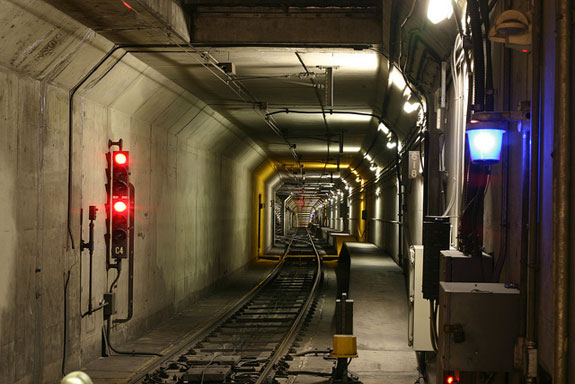SFMTA Transit Director Predicts Better Muni Metro Service in Coming Months
12:39 PM PDT on November 3, 2010

The series of frustrating and consistent delays that have plagued the Muni Metro system for the last few months have been narrowed to three causes that SFMTA Transit Director John Haley told the SFMTA Board yesterday have mostly been fixed for now.
Still, according to Haley, it's "too early to declare victory" on a problem with the sander hoses under the Breda light-rail vehicles that have been tearing the automated signal cables that sit between the rails.
Haley, who updated the board at the request of SFMTA Director Malcolm Heinicke, explained that the vast majority of delays have been caused by signal failures with the Automated Train Control System (ATCS) when the trains have to switch from manual to automatic as they exit the surface streets and enter the underground tunnels at West Portal, the Ferry Building and Church and Duboce streets. Problems with the ATCS have persisted since Muni first acquired the system 11 years ago.
On average, the ATCS failed to get a signal from trains more than 200 times each month in September and October. Every time that happens, the system "fails safely," and slows down every line.
"The cause of that is either something in the wayside or something in the vehicle," said Haley. "The impact of that from a service perspective is when the train's not recognized it puts it in manual. There's a restrictive set of procedures that must be followed. The safety spacing is increased so the system is slowed down."
Haley said the agency has been working in concert with the signal manufacturer, Thales, to try and resolve the problem. Last month, the ATCS got a software upgrade and since then the signal failures have decreased by more than 50 percent.
"What that tells us is that the software fix is working, that the trains are accepting and getting automatic train control. In addition to that, what we need to continue looking at is the maintenance of the wayside equipment and other causes on the vehicle that may cause a train not to get the signal system," he said.
SFMTA spokesperson Paul Rose said they are also working with Thales to do a more thorough upgrade to the ATCS.
Another problem that has proven just as difficult is sander hoses underneath the trains slicing signal cables. It's happened an average of a dozen times each month in the last few months. The sander hoses are used to drop sand on the tracks in the event of an emergency brake application. For the fourth time since Muni acquired the Breda light-rail vehicles, 130 trains currently in operation have now undergone a sander hose retrofit, but there have been at least three slicings in the past 10 days.
"I'd like a little more time to be able to say that we've got the problem cured and this is the right fix for us so we'll continue to work with vehicle engineering on that," said Haley. "The service impacts of this have been very, very difficult because in the situation I described delays can extend for long periods of time."
Eventually, said Haley, the plan is to replace all of the signal cables but it doesn't make sense to replace them until the sander hose issue is fixed.
Another problem causing the delays is "disturbed blocks." The system recognizes a train by counting axles, explained Haley, "so if there's six axles in a particular block the system knows there's a train there."
"On occasion, a block will go disturbed and what that means is that there's something, either a piece of metal, a piece of a track break or some other metal that could be loose or hanging from the undercarriage of the car that tells the intelligence of the system that you've got another axle in there. In that particular case what happens again is the system 'fails safe,' you go to manual and you take a train and you clear the block," he said.
Although this problem hasn't caused as many system-wide delays as the other issues, Haley said it happened on average 50 times each month in September and October.
In earlier interview with Streetsblog, Haley said he had also been challenged by the special events that occurred over the past few months, including the extra service that was added for the Giants games. On the plus side, since LRV service was fully restored in September after the St. Francis Circle Project was completed, operator availability has been at 98 percent and the agency has been meeting its car availability. He said the line management center has improved the overall management of the system and he's been careful not to over-schedule trains.
"I think the situation would have been much worse from a service delay perspective had we not been more aggressive in the way we've been adjusting service," he said.
Heinicke thanked Haley for his presentation and for confirming the delays "were not just an odd coincidence for me," but he pressed him on whether service would get better in the next few months.
"The riders I encounter daily, the people who call or email me, they want to know: is the system crumbling and are we going to have to expect more of this or were September and October an aberration in part because of problems that you had started fixing long ago. A more direct way to ask that question is, will the LRV service in November and December of this year be better than it was in September and October of this year?"
"Okay, I will stretch the crystal ball here but I would say yes," Haley responded
Stay in touch
Sign up for our free newsletter



